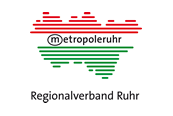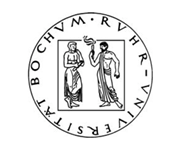Main topic: Perspectives for the future
Subtopic: The framework of the ?Metropolis Ruhr?
The megatrends of change comprise
- The economic and technological change (basic generation of communication and information technologies; increasing importance of finances and failing governmental steering; spread/transfer of the classical economic power of the triad into the emerging countries.
- Globalisation causes an increasing networking and makes basic social fields uniform and mono-structural (economy and financial markets, culture and politics, environmental issues). There is an interaction between a liberalized trade and the new communication, information and transport technologies.
- Demographic and social change (less ? older ? more varied; change of values: separating of the life-style; position of the woman/family; increasing flexibility of the working and living spheres; disparities between poor and rich)
- Climatic change (new and partly yet unknown challenges of urban development by rising temperatures and extreme weather events)
- Change of politics and society: in the process of modernisation from the neo-Keynesian welfare state to a national competition state, closely connected with the excessive indebtedness and a decrease of the financial capital the number of loser is increasing, indicating a failure of steering powers. The change of the political steering approach that was focussed on deregulation, on step by step projects and on sustainability, seems to turn into the contrary in the course of the global competition of modernisation.
To overestimate the regional capability of steering and the creative power is a prevailing attribute of the regional planning approaches in the Ruhr. Even if the endogenous potentials (e.g. competence fields economy, revitalisation of brown fields, poly-centrality of the region etc) can be fully developed and an inter-communal cooperation could be established, there are confusing and turbulent dynamics of change in the exogenous mega trends that superimpose incalculable influences on the structural policy.
From ?Ruhrgebiet? to ?Metropole Ruhr? To think of the Ruhr as ?metropolis Ruhr? has various intentions. First of all it was important to get rid off the persistent negative image of the Ruhr but new terms as ?Ruhrstadt? or ?Rhein-Ruhr-Region? have not been successful. But as it became apparent that the development impulses of the knowledge-based society were successfully concentrated in the large global innovative metropolitan areas and as metropolitan areas were given preference by the national development planning the term ?Ruhrgebiet? which has been associated with old industrial areas, with a negative image and with decline was changed for ?Metropole Ruhr? which is widely accepted since then.
There are four functions attributed to a metropolitan area: (1) It is the ability in innovation and (global) competitiveness than can count on the local companies, research institutions, technology transfer processes as well as a (highly) qualified knowledge-based workforce, (2) it is the ?gateway? function that represents open-mindedness as well as availability (international airport, fairs, congresses and conventions), (3) it is the function of decision-making and steering (seat of the government, top policy-making function, headquarters of companies), (4) it is the symbolic function (international prestige, cultural attractiveness, internationally renowned urban qualities)
With respecs to these four functions and compared to other global or European metropolitan areas the Ruhr is far away from being a metropolitan area. Consequently, to models have been derived to strengthen the ?minor? metropolitan area Ruhr. The first one is orientated to a metropolitan area Rhein-Ruhr with a population of 11 million inhabitants that is regarded as internationally compatible in terms of size and functional capability. Due to remarkable differences and mutual resistance to cooperation this model is not very promising. The second model is to strengthen the Ruhr as a ?metropolitan area with a special character?.
Subtopic: Perspectives of the ?Metropole Ruhr? I
The different character of the metropolitan area Ruhr is defined by its poly-centric structure of 53 cities. It also includes the industrial past and the competence in structural policy deriving from it. Emerging countries (e.g. China) regard the experiences in regional development policy gained over decades in the ?living lab? as model achievements. As the Ruhr has entered the demographic change process 20 years earlier than other European countries the pioneer task also includes the challenges to development and structures connected with this process.
The IBA Emscher Park and ?European Capital of Culture Ruhr 2010? experiences allow a new dimension of regional planning: the time has come for a new ?project of the decade? that is able to join together finances and ideas.
The conversion of brown fields has quite seldom been influenced by comprehensive planning objectives or basic concepts. The driving force of the market has changed from supply to demand; to reject an investor?s wishes will remain an exception. The short term competition for investors has produced a patchwork of only selective renovations in the Ruhr.
This seems to be little, the great challenges of the innovative power of the cities of the Ruhr caused by the climatic and demographic changes are yet to come.
Subtopic: Perspectives of the ?Metropole Ruhr? II
Experiments in the ?metropolitan area with a special character?
- Limited financial scopes and a massively increasing need for reorganization (infrastructure, estate market, economic structure) will require a highly qualitative regional governance of the ?promoting? state. In the current early stage of establishing a regional development master plan this new way of thinking is introduced by a wide regional discourse that precedes the fixation of the plan.
- Co-opetition, a balance of co-operation and competition, between local communities and regional organisations as the RVR, the ?Initiativkreis Ruhr/IR? and the ?Städteregion Ruhr? is required. The IR fosters the vision of the global metropolitan area Ruhr, whereas the RVR pragmatically prefers a disconnected multitude of projects. The ?Städteregion Ruhr?, the first attempt of co-opetition, takes the master plan Ruhr as an example of a bottom-up planning procedure. However, a communication between these organisations does not exist.
- To follow the classical idea of a monocentric highly urbanised metropolitan area makes forget the chances of the regional suburban structures of the ?Zwischenstadt? (urban sprawl). The ?metropolitan area with a special character? might take up the idea of an urban landscape that is intertwined with an attractive post-industrial urban nature.
- The processes of re-urbanisation ?Zwischenstadt? concept could be integrated into the model of a ?de-concentrated concentration?.
- This model requires promising innovations of decentralized infrastructural networks. To develop and test smaller service units could provide chances for the regional economy. Until now these aspects are still widely left aside disregarding both the climatic and energetic changes.
- Following the ?living lab? tradition a pioneer function could be achieved again in finding answers on the challenges of the climatic change.
- The taboo has to be taken from the shrinking processes, they must not be regarded as failures but as potentials for urban renewal and a ?reducing? of the urban fabric.
- The losses of population, human capital, companies, jobs and purchasing power have to be included into the planning perspectives for the suburban areas as well, but models for a ?post-suburbia? are still missing.
- The ethnical variety of the Ruhr, particularly in the deprived quarters north of the ?social equator? (motorway A40) offers a lot of potential for social innovations. Cultural and ethnic diversity management is primarily not a problem in terms of parallel living spheres and a deficit integration but should be regarded as a chance. Local community based ethnic economy very often is a motor of growth.
- On some brown fields the given chances have successfully been used by innovative and prestigious lighthouse projects. They can clearly be seen from outside as they shine wide into the world, but they often leave their vicinities in the dark. A patchwork management that connects these lighthouses and their neighbourhoods is still missing.
- Disregarding some too small IBA projects both the concept of sustainability as the guiding directive of the future and the reuse of brown fields as the centennial chance of urban renewal eke out an existence (?Lokale Agenda 21?, the Land initiative ?Allianz der Fläche?, individual projects of the ?Integrierte Stadtentwicklung? program).
To the abstracts of other main chapters:
1. Fundamentals and beginnings
2. The era of the coal and steel industry
3. Renewing the infrastructure
4. Renewing urban areas
5. Renewing the economy
1. Fundamentals and beginnings
2. The era of the coal and steel industry
3. Renewing the infrastructure
4. Renewing urban areas
5. Renewing the economy



